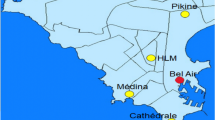Abstract
Accurate and reliable long-term runoff forecasting is very important for water resource system planning and management. This study utilized three data-driven models to simulate and forecast the monthly runoff series of the Huangzhuang hydrological station from 1981 to 2017. To improve the accuracy and reduce the uncertainty, two model averaging techniques were applied to merge forecast results of the different models, and 90% confidence intervals were derived using Monte Carlo sampling. Several indices were used to evaluate the results of three data-driven models and two model averaging techniques. Among the many discoveries in this paper, the following stand out: (i) in general, the random forest (RF) algorithm presented nearly the same accuracy as did the artificial neural network (ANN) algorithm, and both were superior to the support vector machine (SVM) method; however, none of the models consistently provided the best result in all months; (ii) the comparison of the deterministic results indicated that Copula-Bayesian model averaging (BMA) exhibited smaller errors than did BMA, especially for the points whose uniform quantiles ranged within (0.125, 0.35) and (0.5, 0.625); and (iii) in most cases, the 90% confidence interval of the Copula-BMA scheme had higher containing ratio values, smaller average relative bandwidth values in the high-flow months, and smaller average relative deviation amplitudes than did BMA.






Similar content being viewed by others
References
Anghileri D, Voisin N, Castelletti A, Pianosi F, Nijssen B, Lettenmaier DP (2016) Value of long-term streamflow forecasts to reservoir operations for water supply in snow-dominated river catchments. Water Resour Res 52(6):4209–4225
Aqil M, Kita I, Yano A, Nishiyama S (2007) A comparative study of artificial neural networks and neuro-fuzzy in continuous modeling of the daily and hourly behaviour of runoff. J Hydrol 337(1–2):22–34
Box GE, Cox DR (1964) An analysis of transformations. J R Stat Soc Ser B Methodol 26:211–252
Breiman L (2001) Random forests. Mach Learn 45(1):5–32
Cortes C, Vapnik V (1995) Support-vector networks. Machine Learning 20(3):273–297
Duan Q, Ajami NK, Gao X, Sorooshian S (2007) Multi-model ensemble hydrologic prediction using Bayesian model averaging. Adv Water Resour 30(5):1371–1386
Jain A K, Mao J, Mohiuddin K M. (1996) Artificial neural networks: A tutorial. Computer (3), 31–44
Laio F, Tamea S (2007) Verification tools for probabilistic forecasts of continuous hydrological variables. Hydrol Earth Syst Sci 11(4):1267–1277
Li B, Liang Z, Bao Z, Wang J, Hu Y (2019) Changes in streamflow and sediment for a planned large reservoir in the middle Yellow River. Land Degrad Dev 30(7):878–893
Liang Z, Li Y, Hu Y, Li B, Wang J (2018) A data-driven SVR model for long-term runoff prediction and uncertainty analysis based on the Bayesian framework. Theor Appl Climatol 133(1–2):137–149
Lin JY, Cheng CT, Chau KW (2006) Using support vector machines for long-term discharge prediction. Hydrol Sci J 51(4):599–612
Madadgar S, Moradkhani H (2014) Improved Bayesian multimodeling: integration of copulas and B ayesian model averaging. Water Resour Res 50(12):9586–9603
Madadgar S, Moradkhani H, Garen D (2014) Towards improved post-processing of hydrologic forecast ensembles. Hydrol Process 28(1):104–122
Raftery AE, Gneiting T, Balabdaoui F, Polakowski M (2005) Using Bayesian model averaging to calibrate forecast ensembles. Mon Weather Rev 133(5):1155–1174
Risko SL, Martinez CJ (2014) Forecasts of seasonal streamflow in west-Central Florida using multiple climate predictors. J Hydrol 519:1130–1140
Shiri J, Kisi O (2010) Short-term and long-term streamflow forecasting using a wavelet and neuro-fuzzy conjunction model. J Hydrol 394(3–4):486–493
Sklar M (1959) Fonctions de repartition an dimensions et leursmarges. Publ Inst Statist Univ Paris 8:229–231
Sun W, Trevor B (2018) Multiple model combination methods for annual maximum water level prediction during river ice breakup. Hydrol Process 32(3):421–435
Tiwari MK, Chatterjee C (2010) Development of an accurate and reliable hourly flood forecasting model using wavelet–bootstrap–ANN (WBANN) hybrid approach. J Hydrol 394(3–4):458–470
Turan ME, Yurdusev MA (2014) Predicting monthly river flows by genetic fuzzy systems. Water Resour Manag 28(13):4685–4697
Wang QJ, Schepen A, Robertson DE (2012) Merging seasonal rainfall forecasts from multiple statistical models through Bayesian model averaging. J Clim 25(16):5524–5537
Wang WC, Chau KW, Xu DM, Chen XY (2015) Improving forecasting accuracy of annual runoff time series using ARIMA based on EEMD decomposition. Water Resour Manag 29(8):2655–2675
Xiong L, Wan M, Wei X, O’Connor KM (2009) Indices for assessing the prediction bounds of hydrological models and application by generalised likelihood uncertainty estimation. Hydrol Sci J 54(5):20
Xu J, Chen Y, Li W, Nie Q, Song C, Wei C (2014) Integrating wavelet analysis and BPANN to simulate the annual runoff with regional climate change: a case study of Yarkand River, Northwest China. Water Resour Manag 28(9):2523–2537
Yang T, Asanjan AA, Welles E, Gao X, Sorooshian S, Liu X (2017) Developing reservoir monthly inflow forecasts using artificial intelligence and climate phenomenon information. Water Resour Res 53(4):2786–2812
Yarar A (2014) A hybrid wavelet and neuro-fuzzy model for forecasting the monthly streamflow data. Water Resour Manag 28(2):553–565
Yatheendradas S, Wagener T, Gupta H, Unkrich C, Goodrich D, Schaffner M, Stewart A (2008) Understanding uncertainty in distributed flash flood forecasting for semiarid regions. Water Resour Res 44(5):W05S19
Acknowledgments
This study was supported by the National Key Research and Development Program of China (2016YFC0402706), the National Natural Science Foundation of China (41730750), the Postgraduate Research & Practice Innovation Program of Jiangsu Province (KYCX17_0412), and the Fundamental Research Funds for Central Universities (2017B609X14), Qing Lan Project and the project of China Scholarship Council.
Author information
Authors and Affiliations
Corresponding author
Ethics declarations
Conflict of Interest
None.
Additional information
Publisher’s Note
Springer Nature remains neutral with regard to jurisdictional claims in published maps and institutional affiliations.
Rights and permissions
About this article
Cite this article
Huang, H., Liang, Z., Li, B. et al. Combination of Multiple Data-Driven Models for Long-Term Monthly Runoff Predictions Based on Bayesian Model Averaging. Water Resour Manage 33, 3321–3338 (2019). https://doi.org/10.1007/s11269-019-02305-9
Received:
Accepted:
Published:
Issue Date:
DOI: https://doi.org/10.1007/s11269-019-02305-9




